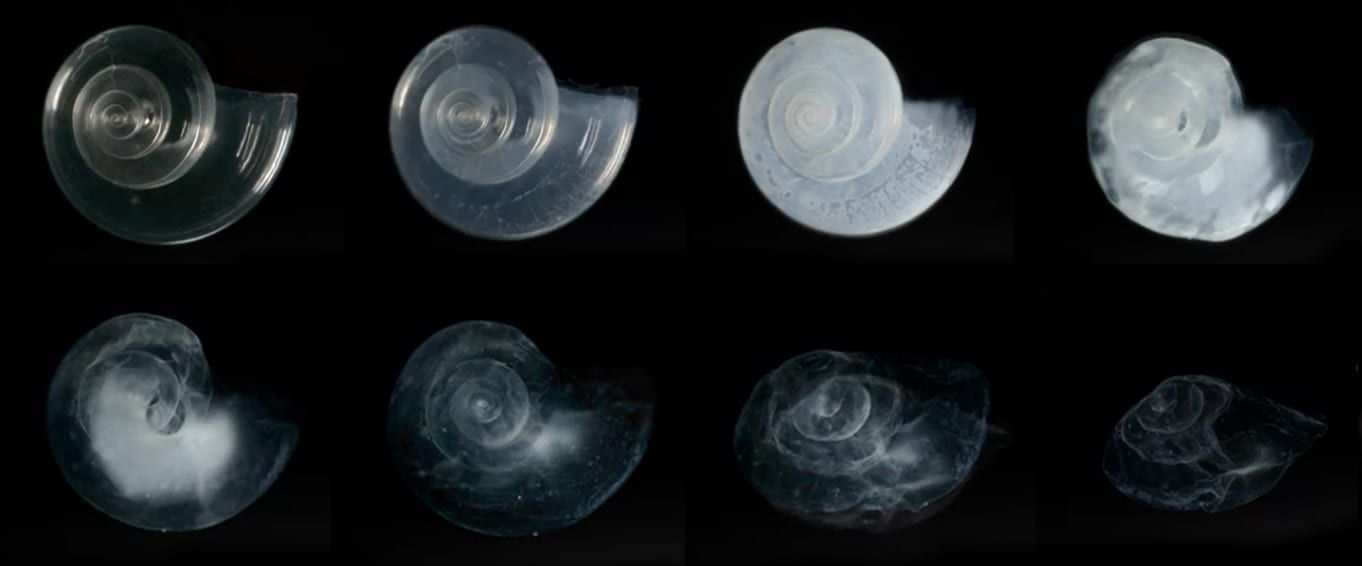
Ocean Acidification in New York State: What to expect and what's being done for a changing ocean
Human activities are gradually changing the chemistry of the ocean and estuaries around the world, and New York State is expected to be particularly vulnerable. As carbon dioxide emissions and polluted waters enter the marine environment, the waters become more acidic and less suitable for certain species. For shellfish like oysters, it will become harder and harder to build their calcium carbonate shell and survive in these conditions. The full extent of this anthropogenic threat to marine ecosystems is not well understood, but proactive efforts are needed to protect the social, economic, and ecological well-being of New York State.
What Is Ocean Acidification?
The above image shows a pteropod shell over the course of 45 days during which it was exposed to ocean acidification levels predicted for the year 2100.
The chemistry of our oceans is changing as carbon dioxide emissions dissolve into the water. Around the world this is making the pH lower, or more acidic, and it is becoming harder for some animals, such as oysters and corals, to get minerals from the water to build their shells. In the coastal waters of New York, nutrient pollution from wastewater and fertilizer makes the pH changes more severe. To make matters worse, colder water can hold more carbon dioxide, so regions at higher latitudes, such as the Northeast United States, will see quicker acidification relative to tropical regions. Explore this website to learn more about ocean acidification.
New York State Ocean Acidification Task Force
On August 22, 2018, the NYS Department of Environmental Conservation (DEC) officially announced the formation of the New York State Ocean Acidification Task Force and the members who will be serving on it. The group of marine science, economics, policy, and industry experts will work to assess impacts of acidification in New York and recommend actions to address negative impacts.
“Governor Cuomo established New York’s Ocean Acidification Task Force to ensure that the best available science is used to assess and respond to this emerging threat to our coastal waters and fisheries. The Task Force is charged with providing New York with the tools and information to protect our natural resources from changing ocean chemistry and safeguard the long-term sustainability of our fisheries.”
-DEC Commissioner Basil Seggos
Read more about the Task Force in the full press release and on the official Task Force website. Explore the Task Force website to find announcements of public meetings, summaries of meetings, and other news about the progress of the Task Force.
Stony Brook University’s School of Marine and Atmospheric Sciences

Several scientists at the Stony Brook University School of Marine and Atmospheric Sciences (SoMAS) are actively involved in studying the oceanographic patterns of acidification in the waters off of New York, and the potential effects on marine animals. For example, some graduate students are testing how Long Island’s famous oysters can hold up with excess carbon dioxide. Another group of researchers is beginning to take shallow and deep measurements of ocean pH and carbon dioxide content. There is also a focus on how these changes will affect New York residents and what we can do to mitigate the problem. Three scientists from the SoMAS, Drs. R. Lawrence Swanson, Carl Safina, and Malcolm Bowman, will be offering their oceanographic expertise as members of the Ocean Acidification Task Force. In addition, a support team of DEC officials and SoMAS graduate students, staff, and professors is working together with the Task Force to organize and publicize meetings so that members of the public are informed about the proceedings. This support team will also participate in the composition of the Task Force’s final report to the governor by offering additional knowledge on acidification, marine science, and policy.
Photo of waves at dawn at Smith Point Beach, NY: NOAA National Weather Service Collection
Photos of pteropod shell: NOAA Environmental Visualization Laboratory
Photo of R/V Seawolf: School of Marine and Atmospheric Sciences

